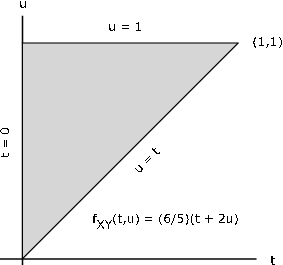| << Chapter < Page | Chapter >> Page > |
The calculations extend to . Instead of values of u j we use values of in the calculations. Suppose .
G = u.^2 - 2*t.*u; % Z = g(X,Y) = Y^2 - 2XY
EZX = sum(G.*P)./sum(P); % E[Z|X=x]disp([X;EZX]')0 1.5000
1.0000 1.50004.0000 -4.0500
9.0000 -12.8333
Suppose the pair has joint density function . We seek to use the concept of a conditional distribution, given . The fact that for each t requires a modification of the approach adopted in the discrete case. Intuitively, we consider the conditional density
The condition effectively determines the range of X . The function has the properties of a density for each fixed t for which .
We define, in this case,
The function is defined for , hence effectively on the range of X . For any reasonable set M on the real line,
Thus we have, as in the discrete case, for each t in the range of X .
Again, we postpone examination of this pattern until we consider a more general case.
Suppose the pair has joint density on the triangular region bounded by , , and (see [link] ). Then
By definition, then,
We thus have
Theoretically, we must rule out since the denominator is zero for that value of t . This causes no problem in practice.

We are able to make an interpretation quite analogous to that for the discrete case. This also points the way to practical MATLAB calculations.
This interpretation points the way to the use of MATLAB in approximating the conditional expectation. The success of the discrete approach in approximating the theoretical valuein turns supports the validity of the interpretation. Also, this points to the general result on regression in the section, "The Regression Problem" .
In the MATLAB handling of joint absolutely continuous random variables, we divide the region into narrow vertical strips. Then we deal with each of these by dividing thevertical strips to form the grid structure. The center of mass of the discrete distribution over one of the t chosen for the approximation must lie close to the actual center of mass of the probability in the strip. Consider the MATLAB treatment of the exampleunder consideration.

Notification Switch
Would you like to follow the 'Applied probability' conversation and receive update notifications?